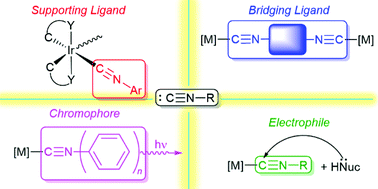The diverse functions of isocyanides in phosphorescent metal complexes
Abstract
In this Perspective, we highlight many examples of photoluminescent metal complexes supported by isocyanides, with an emphasis on recent developments including several from our own group. Work in this field has shown that the isocyanide can play important structural roles, both as a terminal ligand and as a bridging ligand for polynuclear structures, and can influence the excited-state character and excited-state dynamics. In addition, there are many examples of isocyanide-supported complexes where the isocyanide serves as a chromophoric ligand, meaning the low-energy excited states that are important in the photochemistry are partially or completely localized on the isocyanide. Finally, an emerging trend in the design of luminescent compounds is to use the isocyanide as an electrophilic precursor, converted to an acyclic carbene by nucleophilic addition which imparts certain photophysical advantages. This Perspective aims to show the diverse roles played by isocyanides in the design of luminescent compounds, showcasing the recent developments that have led to a substantial growth in fundamental knowledge, function, and applications related to photoluminescence.

- This article is part of the themed collection: 2021 Frontier and Perspective articles


 Please wait while we load your content...
Please wait while we load your content...
